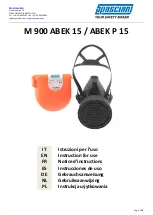
6482-901-01 Rev. A / August 2012
Return to
12-13
Model 6482 Dual-Channel Picoammeter / Voltage Source Reference Manual
Section 12: Remote Operations
Response messages
A response message is the message sent by the instrument to the computer in response to a
query command program message.
Sending a response message
After sending a query command, the response message is placed in the output queue. When the
Model 6482 is addressed to talk, the response message is sent from the output queue to the
computer.
Multiple response messages
If you send more than one query command in the same program message (
), the multiple response messages for all the queries are sent to the computer when the
Model 6482 is addressed to talk. The responses are sent in the order the query commands were
sent and are separated by semicolons (;). Items within the same query are separated by commas
(,). The following example shows the response message for a program message that contains four
single-item query commands:
0; 1; 1; 0
Response message terminator (RMT)
Each response is terminated with an LF (line feed) and EOI (end or identify). The following
example shows how a multiple response message is terminated:
0; 1; 1; 0 <RMT>
Message exchange protocol
Two rules summarize the message exchange protocol:
Rule 1.
You must always tell the Model 6482 what to send to the computer.
The following two steps must always be performed to send information from the instrument to the
computer:
1. Send the appropriate query commands in a program message.
2. Address the Model 6482 to talk.
Rule 2.
The complete response message must be received by the computer before another
program message can be sent to the Model 6482.
RS-232 interface operation
NOTE
RS-232 operation (baud rate, data bits, parity, and terminator) is configured from the
COMMUNICATION option of the main menu. See
,
Sending and receiving data
The RS-232 interface transfers data using 8 data bits, 1 stop bit, and no parity. Make sure the
device you connect to the Model 6482 also uses these settings.
You can break data transmissions by sending a ^C (decimal 3) or ^X (decimal 18) character string
to the instrument, or by sending an RS-232 break condition (holding the transmit line low for >11
bits). This clears any pending operation, discards any pending output, and returns a device clear
(DCL) message.
Summary of Contents for 6482
Page 3: ......
















































